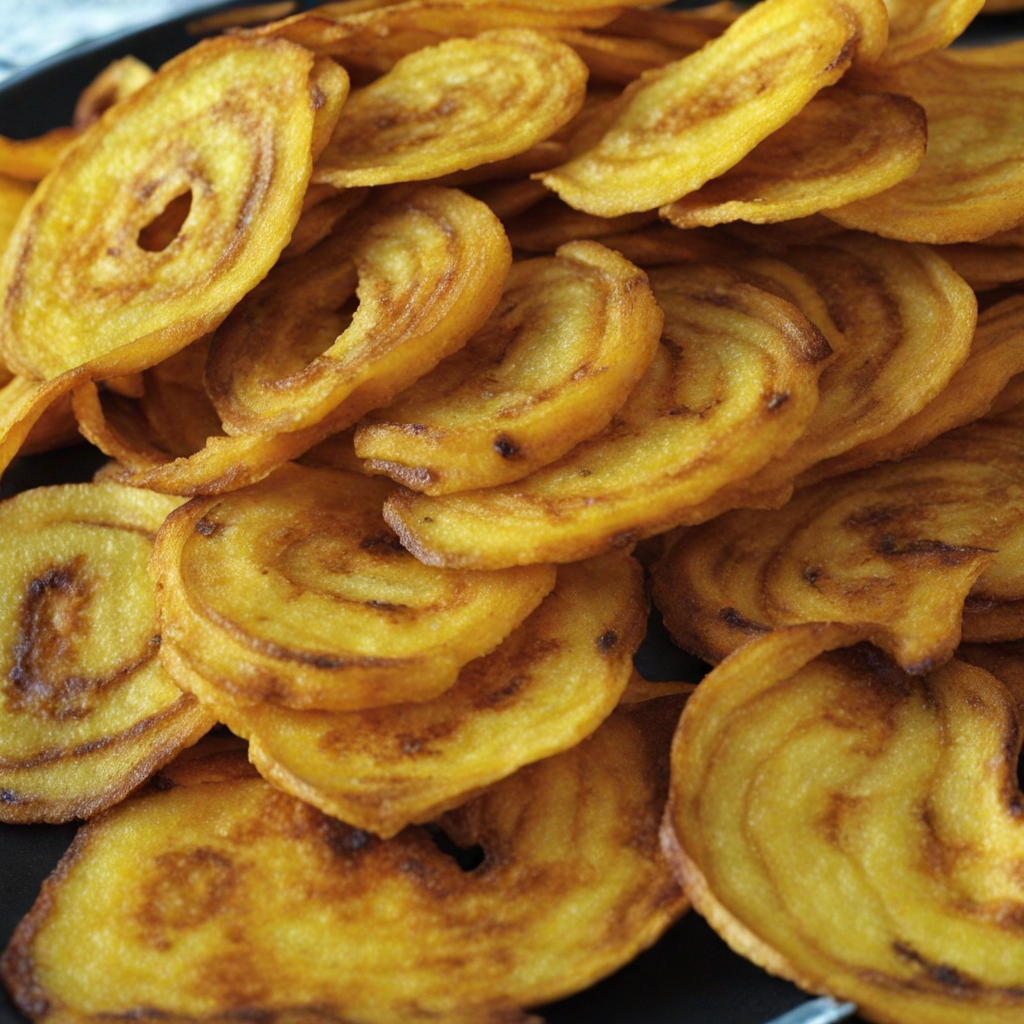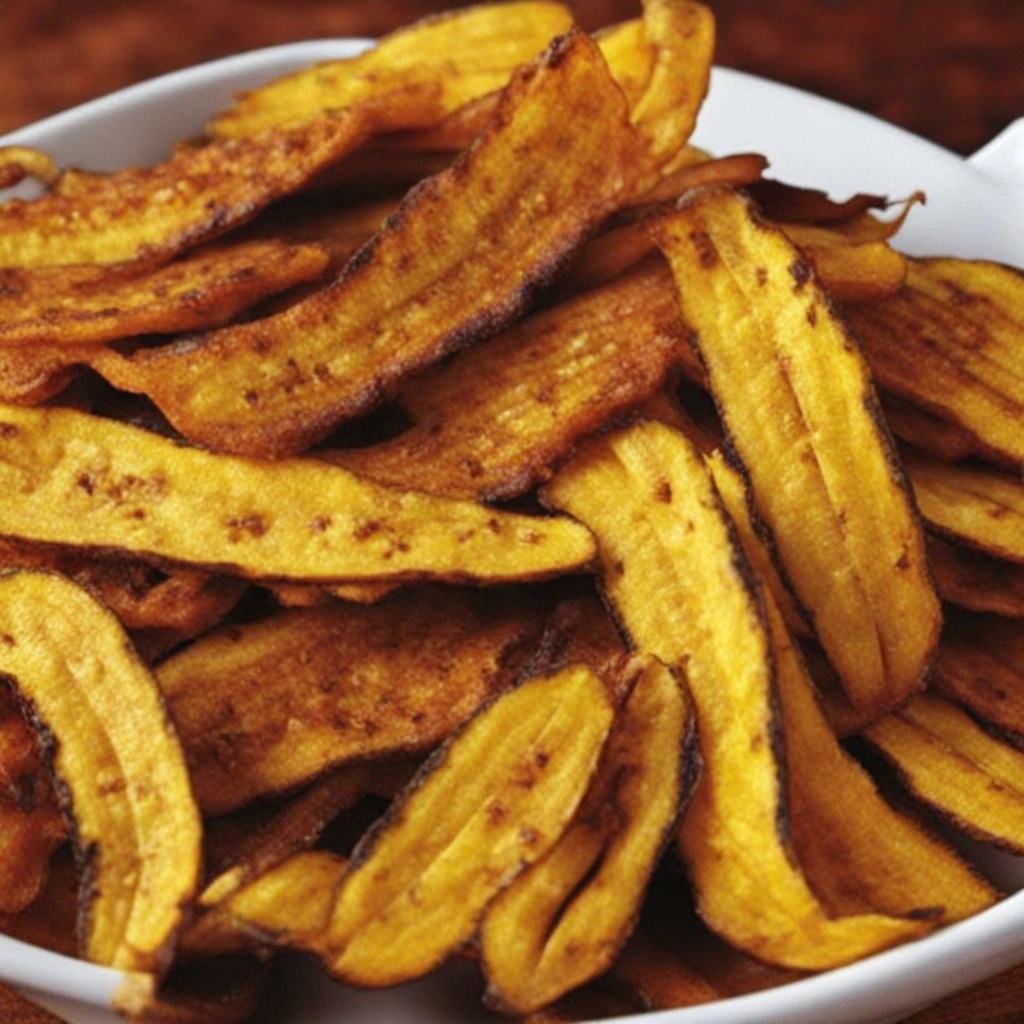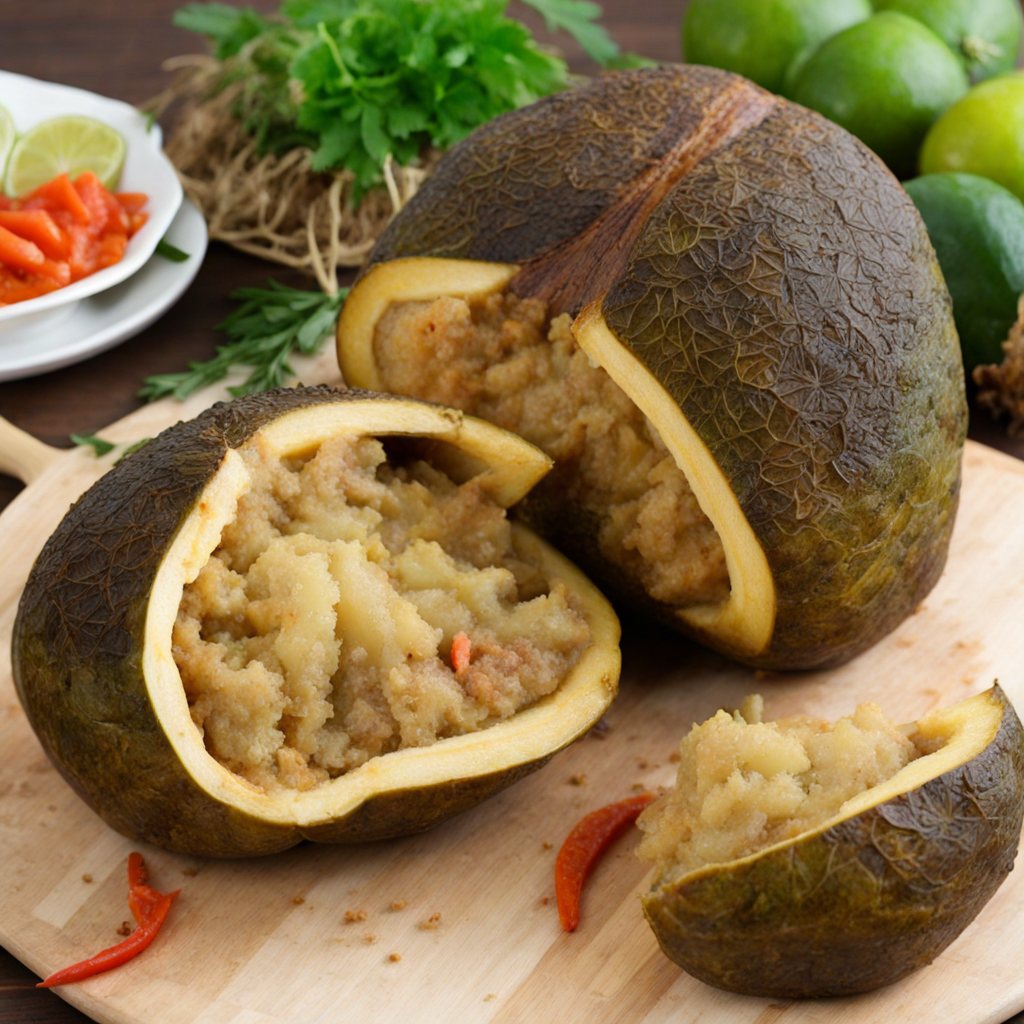Plantain Chips
Plantain chips are a delightful snack hailing from the lush landscapes of Dominica, where the vibrant flavors of the Caribbean come alive. Made from unripe green plantains, these chips are sliced thinly and fried to a perfect crisp. The natural starches of the plantains create a unique texture that is both crunchy and slightly chewy, making each bite a satisfying experience. The subtle sweetness of the plantains complements the savory notes imparted during the frying process, creating a harmonious balance that is irresistible to snack on any time of the day. The preparation of plantain chips involves a simple yet meticulous process. After selecting the best green plantains, they are peeled and sliced into thin rounds, then fried in hot oil until they turn golden brown. Some variations may include a sprinkle of sea salt or spices, enhancing the flavor profile and inviting you to enjoy the delightful crunch. The versatility of plantain chips allows them to be paired with various dips or enjoyed on their own, making them a popular choice for gatherings, picnics, or as a flavorful snack during leisure time. In Dominica, plantain chips not only serve as a tasty treat but also reflect the rich agricultural heritage of the island. They are often enjoyed alongside other local delicacies, showcasing the island's bounty. Whether you are savoring them while basking in the Caribbean sun or sharing them with friends, plantain chips offer a unique taste of Dominica’s culinary culture. Each crispy bite transports you to the island’s vibrant markets and lush plantations, making them an essential part of any food lover's exploration of Caribbean cuisine.
How It Became This Dish
The History of Plantain Chips from Dominica #### Origins of Plantains To understand the significance of plantain chips in Dominica, one must first explore the origins of the plantain itself. Believed to have originated in Southeast Asia, the plantain (Musa paradisiaca) is a staple food in many tropical regions of the world. The fruit made its way to Africa and subsequently to the Caribbean during the transatlantic slave trade, where it became a crucial part of the diet for enslaved peoples and local populations alike. In Dominica, known as the "Nature Island" for its lush landscapes and rich biodiversity, plantains thrived in the fertile volcanic soil, quickly becoming a staple food source. #### Cultural Significance Plantains hold a significant place in Dominican cuisine and culture. They are often seen not just as a food item but as a symbol of resilience and resourcefulness. In many Caribbean communities, plantains are a versatile ingredient used in various dishes—from savory to sweet. Dominicans typically consume both green and ripe plantains. Green plantains are often boiled, fried, or roasted, while ripe ones can be made into sweet dishes or desserts. The practice of making plantain chips is especially notable. The transformation of fresh plantains into crispy, crunchy snacks reflects both culinary creativity and a practical approach to food preservation. Plantain chips are often served as appetizers or snacks during social gatherings, celebrations, and festivals, embodying the spirit of communal sharing and hospitality that is integral to Dominican culture. They are enjoyed by people of all ages, making them a beloved treat in Dominican households. #### The Development of Plantain Chips Historically, the method of preparing plantains has evolved significantly. In the past, plantains were often prepared in large quantities for family meals or communal gatherings. However, the introduction of new cooking methods and techniques has led to the popularization of plantain chips. The process of slicing plantains thinly and frying them dates back several decades but gained widespread popularity in the latter half of the 20th century. The method of making plantain chips is quite simple yet requires skill and precision. First, green plantains are peeled and sliced thinly, often using a mandoline for consistent thickness. The slices are then fried in oil until they turn a vibrant golden brown, resulting in a satisfying crunch. Some recipes call for seasoning with salt or spices, adding an extra layer of flavor to the snack. This adaptability allows plantain chips to cater to diverse palates, making them a popular choice beyond the Caribbean. With the rise of globalization and the increased interest in Caribbean cuisine, plantain chips have found their way into international markets. In the late 20th and early 21st centuries, as Caribbean culture began to gain recognition globally, plantain chips emerged as a trendy snack. They were embraced by health-conscious consumers as a gluten-free alternative to traditional potato chips, and their inherent versatility made them suitable for various culinary applications. #### Modern Popularity and Global Influence Today, plantain chips are not only a cherished snack in Dominica but also a popular item across the Caribbean and beyond. Their ease of preparation and unique taste have made them a staple in supermarkets, health food stores, and even gourmet markets. Many brands have emerged, producing various flavors and styles, from traditional salted chips to more adventurous options like spicy chili or garlic-infused varieties. In Dominica, plantain chips reflect the island's rich agricultural heritage. Locally sourced plantains are often preferred, supporting local farmers and promoting sustainability. The production of plantain chips can also be seen as part of a larger movement toward honoring traditional foodways while adapting to modern tastes. As more Dominicans and visitors alike embrace local culinary traditions, plantain chips serve as a delicious reminder of the island's history and the resilience of its people. #### Plantain Chips in the Culinary Landscape The adaptability of plantain chips extends beyond being a mere snack; they have found their way into various culinary creations. Chefs and home cooks alike have incorporated plantain chips into dishes, using them as a crunchy topping for salads, as a base for canapés, or even as an ingredient in gourmet entrees. Their unique flavor and texture allow them to complement a wide array of dishes, bridging the gap between traditional and contemporary cuisines. Moreover, plantain chips have become an integral part of the global snack culture. They are increasingly featured in fusion dishes, where Caribbean flavors meet other culinary traditions. This cross-cultural exchange has contributed to the growing popularity of plantain chips in diverse settings, from street food stalls in urban centers to upscale restaurants. #### Conclusion The history of plantain chips in Dominica is a fascinating tale of cultural exchange, resilience, and culinary innovation. From their origins in Southeast Asia to their current status as a beloved snack across the globe, plantains have played a significant role in the culinary landscape of Dominica and the Caribbean. As a symbol of community, adaptability, and tradition, plantain chips continue to evolve while remaining deeply rooted in the island's rich history. As more people discover the joys of plantain chips, they not only indulge in a delicious snack but also partake in the vibrant cultural narrative of Dominica. Whether enjoyed at a family gathering, a local festival, or as a snack during a casual evening, plantain chips embody the spirit of the island—one of resilience, flavor, and celebration. With each crunchy bite, one can taste the history and heart of Dominica, making plantain chips a true culinary treasure.
You may like
Discover local flavors from Dominica







